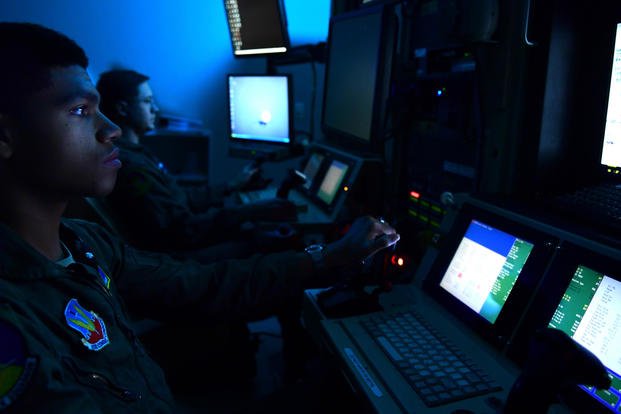With the demand for eyes in the sky growing, the U.S. Air Force needs to distribute and retain drone pilots and sensor operators more effectively to avoid overworking crews, according to a new government watchdog report.
In the report, titled "Air Force Should Take Additional Steps to Improve Aircrew Staffing and Support," published Thursday, the Government Accountability Office said the service should establish a "comprehensive metric -- or set of metrics -- to track the progress" of how it retains remotely piloted aircraft (RPA) pilots and instructor pilots to stave off gaps across the enterprise.
Read Next: Inside the Army’s Decision to Eliminate Photos from Officer Promotion Boards
The GAO noted that, while the overall number of assigned RPA pilots has increased over the years, the service still "does not have enough pilots and sensor operators to meet its staffing targets."
Military.com previously reported that, prior to the MQ-1 Predator's retirement in 2018, the Air Force had more RPA pilots between the Predator community and MQ-9 Reaper community combined than in any manned pilot category. The unmanned program further expanded its reach when it announced in 2015 that enlisted airmen would train to fly the RQ-4 Global Hawk.
But there are gaps in manning, leading to some personnel being overburdened with consecutive missions, the GAO said.
"The trend has not been enough to meet the increased number of authorized positions in this RPA career field," the report states, referring to the approved levels established by Congress. "For a majority of the time in fiscal years 2016 through 2019, the Air Force's number of assigned RPA pilots and sensor operators were less than both of their respective authorizations and requirements.
"For example, for RPA pilots, there was a 22% gap between authorizations -- 1,168 -- and assigned -- 908 -- in August 2015, which was similar to the 20% gap between authorizations -- 1,652 -- and assigned -- 1,320 -- in September 2019," it adds.
The Air Force also wants to better balance RPA crews' combat-to-dwell time: The GAO said the service should scrutinize its structure if it wants to give airmen the ability to separate combat operations from routine training -- which often occur simultaneously -- while also giving them enough time off the clock.
Bonuses have steadily boosted retention, the GAO said, since the Air Force expanded incentives in 2016. But for sensor operators -- the enlisted airmen who track moving targets and conduct strikes -- the bonuses have been less than adequate, according to focus groups held by the GAO.
"In a questionnaire we administered to the 105 participants across the 14 focus groups, nearly half -- 19 of 41 -- of the sensor operators responded they were 'somewhat dissatisfied' or 'very dissatisfied' with their total compensation versus 20% -- 13 of 64 -- of pilots who responded they were 'somewhat dissatisfied' or 'very dissatisfied,'" the report states.
In a response to the GAO's findings, the Air Force said it already has a way to measure accession and production, as well as proper compensation. The GAO re-emphasized that the service needs systemic improvements to monitor RPA pilots to maintain the proper number of personnel over the long term.
The report comes as the Air Force has been weighing how best to execute drone missions in the future and what types of drones it will use in a contested battlefield, as well as how it trains incoming pilots.
Air Force officials have been exploring new equipment to leverage artificial intelligence in the battlespace.
For example, the service's Skyborg project -- launched last year -- will use AI to augment F-35 Joint Strike Fighter or F-22 Raptor teams; the concept is to send out decision-making drones ahead of fighters to act as scouts.
AI drones will also undoubtedly have a role to play in gathering and quickly disseminating information, according to Dr. Will Roper, assistant secretary of the Air Force for acquisition, technology and logistics.
For example, the potential replacement for the Reaper -- known as MQ-Next, aimed at having a more capable drone that can survive hostile environments -- should hone intelligence, surveillance and reconnaissance gathering by adopting algorithmic technologies from the get-go. The service began accepting ideas for this "Next Generation UAS ISR/Strike Platform" earlier this month.
"The way we can really drop the cost per hour of ISR is if algorithms are doing most of the triaging of the raw video, and only sending back to remote operators objects that are of interest that are [important] to look at," Roper said of the program.
He added that it would cut down the number of airmen needed to sift through the data -- something the Air Force has attempted to do for years.
On the instruction side, the Air Force is pursuing a newly created program called RPA Training Next, which takes cues from the Pilot Training Next (PTN) project, according to Air Force Times.
Like PTN, which began in 2018, RPA Training Next will test student aviators' ability to learn faster and absorb more through cutting-edge technology, simulation and virtual reality in its day-to-day training routine.
-- Oriana Pawlyk can be reached at oriana.pawlyk@military.com. Follow her on Twitter at @Oriana0214.
Related: House Lawmakers Add Roadblocks to Air Force's Planned Global Hawk Retirements












